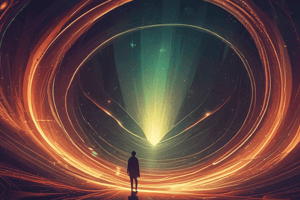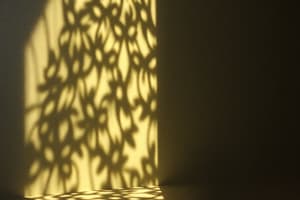Podcast
Questions and Answers
What is the darkest part of a shadow called?
What is the darkest part of a shadow called?
- Penumbra
- Antumbra
- Shadow stick
- Umbra (correct)
What determines the shape of a shadow?
What determines the shape of a shadow?
- The time of day
- The light source's color
- The object's shape and the light source's position (correct)
- The surface's texture
What is the effect of a shadow's size?
What is the effect of a shadow's size?
- Creates an illusion of length
- Creates an illusion of height
- Creates an illusion of depth (correct)
- Creates an illusion of width
Why are shadows used in art?
Why are shadows used in art?
What is the term for the lighter part of a shadow?
What is the term for the lighter part of a shadow?
What is the purpose of a shadow stick?
What is the purpose of a shadow stick?
What is the term for the lighter area outside the umbra?
What is the term for the lighter area outside the umbra?
In which field are shadows used to study the behavior of light and its interactions with objects?
In which field are shadows used to study the behavior of light and its interactions with objects?
What is the effect of shadows in photography?
What is the effect of shadows in photography?
What is the term for using shadows to create puppet shows?
What is the term for using shadows to create puppet shows?
Flashcards are hidden until you start studying
Study Notes
Definition and Formation
- A shadow is a dark area or shape produced by an object blocking light from a light source.
- Shadows are formed when an object or person comes between a light source and a surface, blocking some or all of the light.
Types of Shadows
- Umbra: The darkest part of a shadow, where the light is completely blocked.
- Penumbra: The lighter part of a shadow, where the light is only partially blocked.
- Antumbra: The lighter area outside the umbra, where the light is not blocked but appears fainter.
Characteristics
- Shape: A shadow's shape is determined by the object's shape and the light source's position.
- Size: A shadow's size is affected by the object's distance from the light source and the surface.
- Color: Shadows can appear gray, black, or dark-colored, depending on the light source and surface.
- Depth: Shadows can create the illusion of depth and dimension on a surface.
Applications
- Art: Shadows are used in art to create depth, volume, and mood.
- Photography: Shadows are used to add texture, interest, and emotion to photographs.
- Computer Graphics: Shadows are used to create realistic 3D models and simulations.
- Optics: Shadows are used to study the behavior of light and its interactions with objects.
Fun Facts
- Shadow Stick: A stick or object can be used to measure the time of day by observing its shadow.
- Shadow Puppetry: Shadows can be used to create puppet shows by manipulating objects between a light source and a screen.
- Shadow Illusions: Shadows can be used to create optical illusions, such as making objects appear larger or smaller than they are.
Definition and Formation of Shadows
- Shadows are dark areas or shapes produced by objects blocking light from a light source.
- Shadows form when an object or person comes between a light source and a surface, blocking some or all of the light.
Types of Shadows
- Umbra: The darkest part of a shadow where light is completely blocked.
- Penumbra: The lighter part of a shadow where light is only partially blocked.
- Antumbra: The lighter area outside the umbra where light is not blocked but appears fainter.
Characteristics of Shadows
- A shadow's shape is determined by the object's shape and the light source's position.
- A shadow's size is affected by the object's distance from the light source and the surface.
- A shadow's color can appear gray, black, or dark-colored, depending on the light source and surface.
- Shadows can create the illusion of depth and dimension on a surface.
Applications of Shadows
- In art, shadows are used to create depth, volume, and mood.
- In photography, shadows are used to add texture, interest, and emotion to photographs.
- In computer graphics, shadows are used to create realistic 3D models and simulations.
- In optics, shadows are used to study the behavior of light and its interactions with objects.
Fun Facts about Shadows
- A shadow stick can be used to measure the time of day by observing its shadow.
- Shadow puppetry can be used to create puppet shows by manipulating objects between a light source and a screen.
- Shadow illusions can be used to create optical illusions, such as making objects appear larger or smaller than they are.
Studying That Suits You
Use AI to generate personalized quizzes and flashcards to suit your learning preferences.




